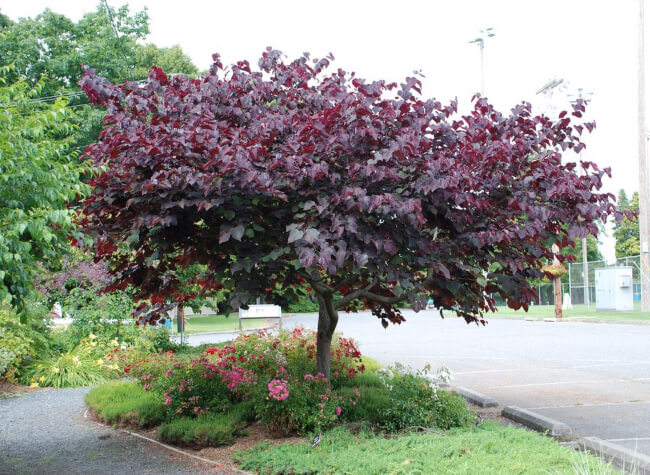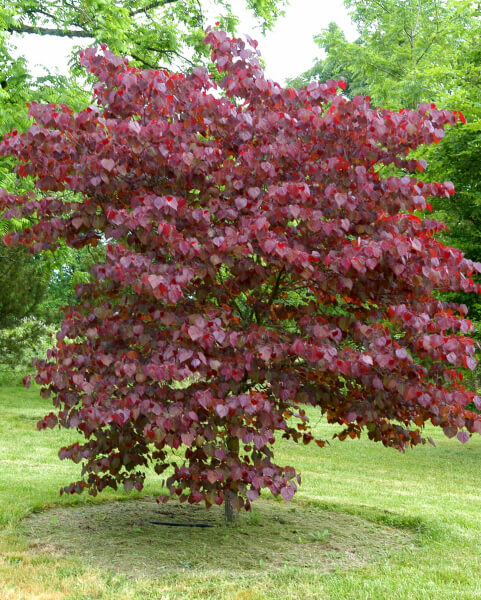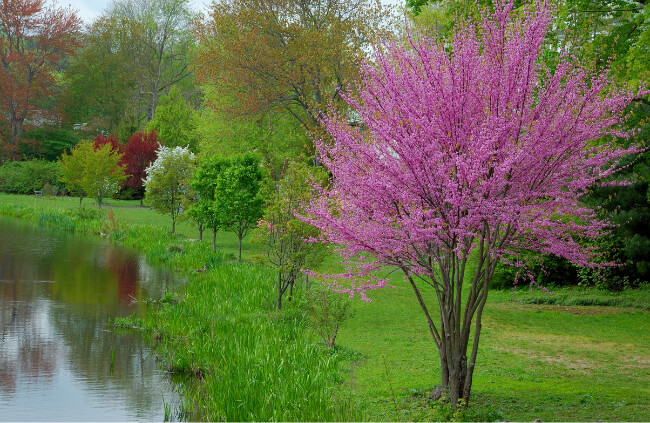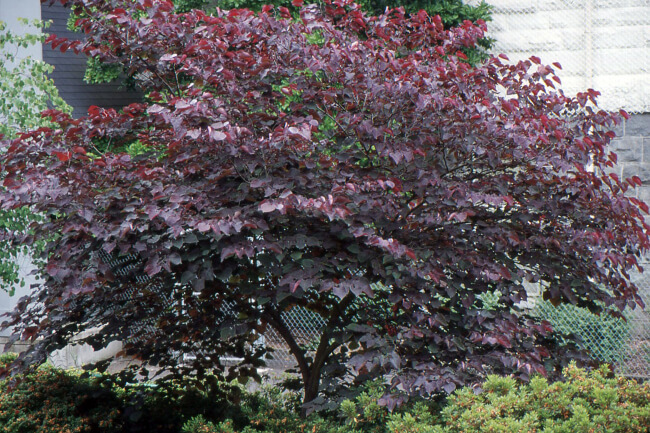Heart-shaped leaves and nectar-rich pea flowers along its stem are what define Cercis canadensis ‘Forest Pansy’, one of the most unusual flowering trees in the world, and part of a small genus of trees known as Cercis.
Small garden trees are usually quite limiting, either offering spring interest, summer structure or autumn colour. Cercis canadensis has it all, with bowing, bare, silvery branches in winter, dazzling blossoms in spring, and stunning summer and autumn colour as its foliage shifts from reds, through greens and into yellows.
Learn all about Cercis canadensis ‘Forest Pansy’, and how to grow it at home in Australia, right here.
More...

Source: Ian Barker Gardens
Family: | Fabaceae |
|---|---|
Genus: | Cercis |
Species: | C. canadensis |
Origin: | North America (up to Ontario, Canada) and central Mexico |
Common Names: | Forest Pansy |
Location: | Outdoor |
Type: | Flowering tree |
Growth: | Up to 8 m (typically 3 m in gardens) |
Sun requirements: | Full sun or dappled shade |
Foliage Colour: | Red and pink |
Flower Colour: | Purple |
Flowering: | Spring |
Edible Parts: | Flowers and seed pods are edible |
Maintenance level: | Low |
Poisonous for pets: | Non-toxic to cats and dogs |
What is Cercis ‘Forest Pansy’?
Cercis canadensis is a naturally multi-stemming tree, growing to around 3 m tall (though sometimes 8 m where there is competition or overhanging trees). One of the most popular cultivars is Cercis ‘Forest Pansy’, known for its distinct and abundant purple-pink flowers in late winter or early spring, and the uniquely purple foliage, which fades boastfully into a golden yellow in late autumn.
The flowers and pods of Cercis canadensis are edible, and before the flowers open, the buds can be used as a delicious substitute for capers.
Natural Habitat of Cercis ‘Forest Pansy’
Cercis canadensis ‘Forest Pansy’ is a bred cultivar, but C. canadensis itself is native to North America, and while it is most notoriously linked to Canada, is more prominent through eastern parts of the USA, down to California, and as far south as central Mexico.
It is completely hardy through frosts, and grows in most conditions where its saplings can develop with some protection from summer sun, usually on forest fringes – though it copes well in open space, and full sun in most gardens.
How to Grow Cercis ‘Forest Pansy’
Cercis ‘Forest Pansy’ grows well in either full sun or dappled shade. It can be kept as a small containerised tree for many years, or planted directly into the garden in open space, where it will usually reach 3 m tall.
Planted beneath other trees, or in the shade of a house, it will grow until it reaches light, to around 8 m.

Source: The Plant Company
Planting Cercis canadensis ‘Forest Pansy’
Cercis canadensis ‘Forest Pansy’ is pretty straight forward to plant. Like any tree, it should be supplied either in a large round, black plastic pot, or a root pruning pot (plastic or hessian).
- Dig a square hole that is at least twice as wide as its current container, and 1 ft deeper.
- Back fill the hole with the existing soil, and tamp down the base (the soil should be workable but firm so roots can move through, but the tree won’t sink once watered).
- Place the tree, without its pot, in the planting hole.
- Stand back, check its position and shape. Make sure it arches where you want it, and move it accordingly.
- Once you’re happy, fill the hole in around the root ball, and firm it in with your heel.
- Provide support by pushing a thick wooden stake into the ground at 45° to the trunk, so it faces into the prevailing wind.
- Loosely tie the stake into the trunk to provide gentle support against the wind.
- Water it in well.
- Mulch with any organic compost.
Soil Preparation for Cercis ‘Forest Pansy’
Before you do any of the above, make sure your soil is in good condition. Any rich but well-drained soil will do fine. Sandy soils are generally too free-raining, and clay can hold moisture, and Cercis will struggle to root through the dense earth.
Improve both sandy soil and clay by digging through organic, peat-free compost before planting. And every year after, add a two inch layer of leaf mould or garden compost to the surface as a mulch.


Get Your Free Guide:
Master Growing Australian Natives eBook
A Must Have Complete Guide for Every Australian Garden
Get Your Free Guide:
Master Growing Australian Natives eBook
A Must Have Complete Guide for Every Australian Garden
Light Requirements
Cercis can cope in part shade or full sun. Heavy shade will cause your Cercis ‘Forest Pansy’ to grow taller, but without the gorgeous multi-stemmed structure they are best known for, so really, the brighter the better.
If you can protect them from the hottest midday sun, that would be ideal, but it’s not essential. For reference, we have two Cercis growing about 5 metres apart.
One gets around four hours a day of extra sunlight, and is two feet shorter, with more branching than the other, and a much better shape as a result. The only difference is that one is slightly closer to the house.
Water Schedule
For the first year after planting, water your Cercis once a week, reducing that to once a month or once a fortnight through winter (when the soil dries out). The following year, water your Forest Pansy during dry spells.
After that, you shouldn’t need to water your Cercis ‘Forest Pansy’ at all, even in dry hot weather.
Growing Cercis ‘Forest Pansy’ in Pots or Containers
Cercis ‘Forest Pansy’ grows well in containers, but should be pruned into a multi-stemmed tree if it isn’t already. Not only will this provide stability, but it will look much, much better in its container, and offer more of a structural piece in the garden.
Plant your Forest Pansy into compost, mixed with garden soil or grit, and add a layer of drainage to the base (polystyrene, broken pots, etc.). After that, keep it well watered, and water it regularly for the rest of its time in the container, ensuring the soil doesn’t dry out completely.
Tip: Under-planting with seasonal colour like violas will help to reduce moisture evaporation, and look beautiful too. Add a monthly liquid feed to your routine, to top up nutrients lost to the annual planting.
How to Propagate Cercis ‘Forest Pansy’
There’s a fascinating article on propagating Cercis canadensis from North Dakota State University, including everything from grafting to tissue cultures, but for the sake of day-to-day gardening, let’s stick to the simpler DIY options; seeds and cuttings.

Source: Heritage Seedlings
Cercis ‘Forest Pansy’ Propagation from Seeds
After flowering, you can harvest seeds as soon as it’s ripe (just as the pods begin to open) and sow them directly into a tray of garden soil. Water in whenever it dries out, and leave it somewhere warm and bright. Germination can take up to a year but is fairly reliable.
With scarification (scratching or breaking down the seed coat in acid) and stratification (cooling seeds to below 5°C for two months), you can successfully germinate dried or saved seeds, but it’s well worth trying to get hold of fresh seeds in spring to make the process simpler.
Propagating Cercis ‘Forest Pansy’ from Cuttings
Cercis cuttings can work but are known to be unreliable. However, as with everything in gardening, it’s worth a go.
If, for example, you’ve pruned out a young shoot that’s going in the wrong direction, dip the cut end in rooting hormone, pop it in a deep pot of compost, and keep it well misted for a month through early summer. If you’re lucky, it’ll work, if not, you’ve not lost anything!
Cercis ‘Forest Pansy’ Care Tips
Once a Forest Pansy has established itself in a garden, and its trunk has a diameter of anything over 15 cm, it doesn't need any ongoing care. Like any tree that’s survived that long in a garden, it will pretty much cope with anything.
But, until that point, there are some important things to continue on with to help your Cercis establish quicker, and maintain good health in the meantime.
Mulching Needs
Mulch young Forest Pansy trees once a year in late winter. Mulching in winter can lock too much moisture in the soil, but a spring mulch offers a nutrient boost, and locks in moisture for the growing season.
I use a mulch made up of 50% rotted horse manure and 50% rotted wood chips on all my tree and shrub borders, but any organic materials will do. The reason I use a mix is that our soil is dense clay along one side of the garden, and over time, the mixed organic mulch will improve its structure. The same can be done with sandy or clay soils for contrasting reasons.
Fertilising Forest Pansy
For Cercis in pots, feed them at least once a month with a liquid feed, or annually with some slow release granular feed or chicken manure pellets.
Pruning and Repotting Cercis ‘Forest Pansy’
Cercis ‘Forest Pansy’ doesn’t need much pruning, but it’s worth removing any damaged branches and keeping an eye out for things like bacterial cankers, or blackened shoots, as these should be cut off and burned.
If you notice branches rubbing and crossing over, choose the best, and remove the other as the rubbing will cause wounds, possibly resulting in infection.
If you want to retain an architectural goblet shape to your multi-stemmed Cercis, cut out about 50% of any new inward-pointing branches each year, to make sure energy focuses in the right direction.
Harvesting and Preparing Forest Pansy
Cercis flowers are edible at every stage, including before they open, and once they’ve been pollinated they develop into seed pods. The buds and flowers in particular offer more vitamin C per gram than an orange, which is pretty incredible.
Me telling you that is all well and good, but what exactly are you going to do with these superfoods?
Edible Uses of Cercis
Cercis Buds
Cercis buds have mildly acidic, salty flavour, making them an ideal substitute for capers. However, you will need to take care when harvesting them.
Cercis flowers emerge from the branches, just above the point where leaves will emerge, so make sure you’re taking the flower buds, not the leaves, and don’t damage the leaf buds as this can mean a leafless tree for the rest of the year.
The buds of Forest Pansy can be used to make jams and cordials, or eaten raw in salads. If you want to claim they’re a superfood, maybe don’t cover them in sugar in jam form though.
Cercis Flowers
Cercis flowers have a citrusy flavour, but with a sweet note too. They are, after all, a great source of nectar for pollinators in spring. There are tons of ways to use them in cooking, but nothing will beat just sprinkling these gorgeous flowers into a salad and enjoying them raw.
Cercis Seed Pods
Seed pods are best harvested before they dry out and stir-fried quickly on a high heat. They’re protein rich, so a great forage food to add to a quick dinner, but don’t have much flavour – probably why they’re not widely known as an edible plant.
Common Cercis ‘Forest Pansy’ Pests and Diseases
Cercis offer a food source for all sorts of creatures, and while they do occasionally get infestations of beetles or leaf hoppers, established trees will easily recover.
In terms of disease, again, Cercis ‘Forest Pansy’ is pretty resilient, and other than common diseases that affect all deciduous trees like canker or leaf spot, they are not usually troubled by diseases.
Leaf borers, caterpillars, leaf hoppers or beetles can be picked off and redistributed around the garden if they are becoming a problem. Canker, notable by swollen splits in bark, like tumours, should be cut off so that any trace is removed.
Canker won’t kill most trees, but it does reduce flowering, and can spread to other plants. In the wrong place it can also cause branches to snap.
Cercis ‘Forest Pansy’ Frequently Asked Questions

How fast does Cercis ‘Forest Pansy’ grow?
Cercis ‘Forest Pansy’ should grow at least 1 ft per year. In some spots they will grow faster, but they usually won’t be as strong.
How hardy is forest pansy?
Forest Pansy is fully frost-hardy, but won’t tolerate high winds until it matures, so it is important to provide some sort of stake to young trees after planting.
Why does my Cercis ‘Forest Pansy’ have green leaves?
Cercis ’Forest Pansy’ is bred to develop rich purple leaves in spring, lightening slightly to a yellow red in autumn, and a bright, custard yellow just before they drop in early winter. When exposed to days and full midday sun, they can produce greener foliage, but the new growth should remain red.
What is the lifespan of Cercis ‘Forest Pansy’?
Cercis ‘Forest Pansy’ has a lifespan of around 70 years in gardens, or at least its species generally does, Cercis canadensis. Forest Pansy is a more recent addition to most gardens, but will likely last for 70 years or longer in most gardens, if not significantly longer.
Is Cercis ‘Forest Pansy’ a tree or a shrub?
Cercis ‘Forest Pansy’ is a small multi-stemmed tree. Multi-stemmed trees are often mistaken for shrubs due to their denser form, but as they develop, it becomes clear quite quickly that they are indeed a tree.
What is the best time to prune a Cercis?
The best time to prune Cercis canadensis is in late autumn or early winter. Alternatively, to promote new growth and bushy red foliage in early summer, cut hard in spring, back to a node.
Do Forest Pansy Trees lose their leaves in winter?
Cercis ‘Forest Pansy’ trees lose their leaves in winter, regardless of the weather, frost, or light levels. They are deciduous trees so require a natural period of dormancy each year in order to flower and jump into new leaves.
Wrapping Up Our Growing and Care Guide for Cercis ‘Forest Pansy’
Cercis ‘Forest Pansy’ are stunning trees, packed with interest from the earliest days of spring to the latest days of winter. Their flowers, emerging unusually along last year’s branches, are vividly beautiful, as well as edible.
If you’re considering any ornamental tree for your garden, and want to think a little bit outside the box, the deciduous Cercis canadensis ‘Forest Pansy’ is truly an outstanding tree to grow.
Published on August 5, 2023 by Maisie Blevins
Last Updated on February 25, 2025





